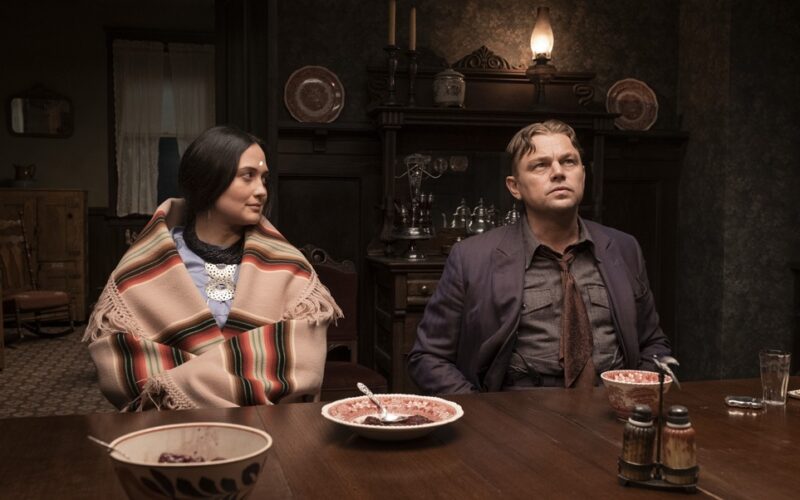Killers of the Flower Moon (Scorsese, 2023)
Killers of the Flower Moon is a new film from Martin Scorsese, which means the first, maybe only, question is whether it is a favorite to win Best Picture. The fact that it is a Scorsese movie means the fact that it will get nominated is a foregone conclusion. But will it win?
Answers to that question will depend on an individual reviewer’s attitudes toward the auteur more than a comparison to other films. It’s certainly the leader in the clubhouse, but first out of the gate doesn’t always mean prohibitive favorite. I find the director’s films a bit oppressive in their scope and severity, and it is hard for me to believe a 220+ minute film is going to marshall broad support outside of those already in the church of Scorses choir.
That said, it’s very good. The story of enterprise corruption is simultaneously familiar and new. Similarities to The Godfather abound, with Leonardo DiCaprio playing Ernest Burkhart. Like Michael Corleone, he is a war veteran who joins his extended family’s criminal enterprise, perhaps thinking that he can reap the benefits of crime without becoming corrupted by it. The measure of his moral decline is shown through his domestic relationship. He marries an Osage Indian who has “head rights” — inheritance of money given to the tribe when oil is found on their land. Ernest’s uncle, Willaim Hale (Rober DeNiro, in a more finely controlled performance that shies away from the caricature of other DeNiro thugs) orchestrates a family syndicate that has white men marry into the Osage women and then murders them in order to inherit.)
If similarities to The Godfather are many, the key difference is that Ernest is portrayed as more gullible and hence more pliable than Michael. He is not so dumb that he doesn’t see what is happening, but he is no criminal mastermind. Unlike Michael, he follows a consistent pattern of capitulation rather than a gradual one, dealing with the cognitive dissonance by pretending that what is happening can’t be happening even as he transfers instructions on how and when to kill his wife’s family. If Michael’s naivete is “that’s not me,” Ernest’s is that the worst atrocities won’t happen to him or his family.
This description can make Ernest sound like a simpleton, but he’s not. At least not exactly. If Michael’s lies at the end of The Godfather are a symbol of his moral decline, Ernest’s third-act equivocations are a symbol of his self-delusion crumbling under reality. Since the targets of violence are narrower in scope than in The Godfather, Ernest’s feeble self-justifications are not only personal (and hence universal) but also symbolic of the national conduct toward Native Americans. If we can see this is wrong on a small scale, why can’t we see it as equally wrong on a large scale?
The ambiguity of Ernest’s moral state only works if DiCaprio is credible, and he is. The horror of The Godfather is that of conscious compromise with one’s own values. The horror of Killers of the Flower Moon is a slightly more common one. It is about what we allow ourselves to do by not interrogating ourselves too closely. It is about learning to soothe our conscience through justifications and evasions rather than blunting our conscience through defiance and anger.
Also, it is worth commenting that the agency of Molly (Lily Gladstone) is a complicating factor in our assessment of the couple. Is she duped by Ernest? She appears fairly clear-eyed about what he wants. Does she, in her way look away from what is obvious to everyone else because her heart wants what it wants? In a key scene she and her female companions converse about the “coyote” (her nickname for Ernest) and how pretty he is.
There are weaknesses. We live in an age that is unlikely to sympathize with those who wield institutional power, so resisting the urge to feel bad for Ernest isn’t really that hard. In a movie like The Godfather, I had to keep reminding myself that the characters were evil because they came across as so human, understandable, and likable that I was horrified by the outbursts of violence — and yet willing to rationalize them. In Flower Moon, the characters (especially DeNiro’s Hale) are so plainly and directly unlikable that I had to remind myself that they, too, are shaped by social forces. Maybe the Osage angle imbues the film with some ambivalence. My favorite Scorsese movies (Silence, The Age of Innocence, and Color of Money) all have villains who don’t think of themselves as such. I find the director’s films tedious when he focuses on characters defiant in their badness (Gangs of New York, The Irishman, Casino, and the dreadful Wolf of Wall Street). Here Hale is self-aware, but he lacks the flamboyance of some Scorsese monsters. As such, it feels a little too didactic, a little too earnest (no pun intended).
But yeah, before you remind me, a lesser Scorsese film is still better than 90% of the studio dreck we will get in a year. I’m not saying it is horrible, just trying to pump the breaks on its coronation.

